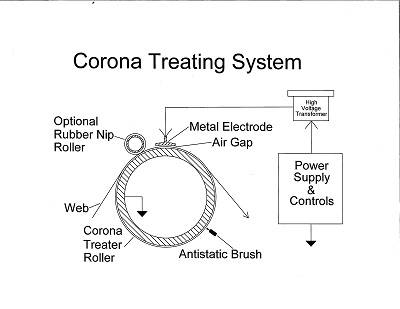Corona Treating System
- Published: January 03, 2020
Plastic films are non-porous and typically have low surface tension. Inks, coatings, and adhesives do not readily wet out or adhere. Corona treatment raises the surface energy of these materials in a way that is uniform and not discernible to the eye.
A corona treater station for treating polymer films consists of a high voltage and high frequency power supply or generator, a linear electrode, and a grounded roller with a small air gap between the electrode and the roller. The corona discharge propagates from the electrode to the film surface.
Depending on the type of system, the roller, the electrode, or both may be covered with a layer of a very good insulating material known as a dielectric. In a conventional or covered roller system, the electrode is bare metal and the grounded roller is covered with a dielectric coating. This is the original type of corona treatment system and can be used for all types of web materials. Grounded idler rollers must be used before and after the corona if the web is electrically conductive.
A second type of system was developed which does not have this inherent problem is called a bare roll treater. The dielectric covering is moved to the electrode and the grounded metal roller is bare metal. A thin layer of an electrically conductive ceramic can be used to prevent oxidation of the metal surface by exposure to the corona.
A third type of system has a dielectric covering on both the electrode and the grounded roller. This dual dielectric system generates a very soft corona which minimizes the potential for web wrinkling and distortion of thin webs. The dielectrics on both the electrode and roller are typically ceramic, but any type of covering can theoretically be used on the roller.
The high voltage and high frequency imposed on the electrode causes the air between the electrode and roller to breakdown into a plasma. Plasma is a state of matter in which some of the outer electrons are stripped off of the gas molecules making an electrically conductive and chemically active kind of soup. The plastic film is briefly passed through the plasma/corona which acts to chemically modify and micro-roughen the surface of the film in a way that increases its surface energy.
Source electrical energy, which creates the corona, is first applied to the metal electrode, or the metallic core of the ceramic covered electrode, at the full voltage that the corona generator produces. By the time the electric field reaches the grounded metal roller, the voltage is zero. In between the metal electrode and the metal core of the roller, the electric field voltage drops each time it passes through a dielectric layer. Dielectric layers include the covering on the electrode (if present), the web if it is a non-conductor, and the dielectric covering on the roller. So the electric field passes through two dielectric layers on conventional and bare roll systems and three layers on dual dielectric systems.
The electric field voltage, which can be compared to water pressure, drops as a result of having to pass through the dielectric layers. How much voltage is lost depends on the electrical properties of the layer and how thick it is. The web is very thin compared to the layers on the electrode or roller and thus has a minimal effect.
In a conventional system, the electric field does not have to pass through any dielectric layers before reaching the surface of the web, so the electric field voltage and the energy available for treatment are maximized.
In a bare roll system, the voltage applied to the metal core of the electrode is the same as a conventional system, but the voltage on the outside of the ceramic electrode is a lower value. The total amount of wattage applied to the web is therefore lower than a conventional system, other things being equal. The voltage also drops as the electric field passes through the dielectric on a covered roller system, but this happens after the film has been exposed to the corona.

A bare roll system can be used to treat metal or conductive webs and all of the same materials as a conventional system. The input power just has to be higher in order to achieve the same treatment levels. How much power is lost to the electrode in a bare roll system varies with the specific design, but 30% would be reasonable estimate.
In terms of efficiency, or the power available for treating for a given input wattage, the dual dielectric system is in between the conventional and bare roll systems. The voltage still drops as it passes through the dielectric on the electrode, but the drop is reduced because the total voltage drop is split between the dielectric on the electrode and that on the grounded roller. This system also becomes more efficient as the thickness of the dielectric on the roller is increased moving more of the voltage drop below the web instead of above. The most common dielectric on the roller is ceramic which is typically thinner than a ceramic covering on a conventional system.
Dielectrics that are used on the grounded metal roller include CSM rubber (originally DuPont Hypalon), silicone rubber, epoxy and epoxy/fiber composites, glass, and ceramic. Some of the first dielectrics used on rollers were CSM and silicone rubber. Both are good insulators, but CSM can be affected by high humidity, which reduces its insulating properties. Silicone rubber is a wonderful insulator, but is weak when it comes to physical properties like wear and cut resistance. The high coefficient of friction of rubber coverings allows the use of light weight web driven rollers.
In order to make the grounded roller cover more durable, epoxy coverings were introduced. Some designs were just solid epoxy resin; others included glass fiber or glass matte making a composite structure. These types were much more cut and wear resistant. All of these organic polymer types of materials (silicone is technically not organic because it does not have a carbon backbone) are subject to repeated chemical attack by the same corona that is treating the film. Over time, the corona can oxidize organic components in the rubber or epoxy turning them into carbon dioxide and water and leaving behind the non-reactive or inert components like mineral fillers. These become a dusty layer on the roller surface. In the extreme case, this erosion effect can make grooves or pits in the roller surface filled with powder.
Ceramic and glass insulating roller coverings were introduced in the 1970s and are about half the thickness of the other types of coverings. Both types are not affected to any great extent by direct chemical attack of the corona, are cut and abrasion resistant, and much more thermally conductive than the organic types making them easier to cool in service. Because of this, ceramic and glass roller coverings can handle twice the wattage of a rubber or epoxy covering of the same surface area, or the roller diameter can be cut in half. Both types also have a longer service life than the organic materials, but are also more expensive.
Two of the most important electrical properties of roller coverings are dielectric strength (resistance to arc through) and dielectric constant (capacitance). The typical corona treater generator produces 10-12 kV RMS at the electrode. This is an AC system, so the peak voltages at the electrode are in the range of 17 kV or more. The dielectric strength of the roller covering has to be able to continuously resist this voltage without breaking down and arcing through. Since the dielectric strength of all dielectrics drops as the temperature increases, it’s always a good idea to keep the grounded roller as cool as possible. This also extends the product life of the roller covering.
The capacitance of roller-electrode combination can vary widely due to variations in the dielectric constants of the materials and thicknesses of the coverings. At the extremes, the dielectric constant of ceramic is nearly three times higher than silicone. The other coverings are more in the lower middle part of the range. Ceramic and glass coverings are also 20 to 50% thinner than the other types of coverings. The capacitance created by the combination of the roller and covering, and the area of the electrode can vary by as much as six times or more.
A change in capacitance can affect the efficient operation of the corona generator. Before changing from one type of covering to another, it’s always wise to check with the corona generator manufacturer.
Corona treater generators are alternating current (AC) systems, meaning that the capacitance and inductance in the system need to be balanced in order for the generator to operate efficiently. Replacing a silicone covered roller with a ceramic covered roller may cause the generator to not work efficiently depending on how old it is. Generators built before the late 1990s were fixed frequency and could only compensate for about 20% variation in the roller capacitance without changing either the electrode area (capacitance) or the output transformer (inductance) to achieve a balanced system. Later and current designs are variable frequency (usually in the 10 to 30 kHz range). This type can vary its output frequency in order to achieve the required balancing of capacitance and inductance factors.
Which Roller Covering is the Best?
All roller coverings can produce excellent results in terms of the treatment level and uniformity, if the corona system is properly tuned and maintained, but each type has its limitations. Silicone, CSM, and epoxy coverings are generally low in cost and produce good results for most applications. Epoxy is much more resistant to cuts and abrasions than the others, but they all can be attacked by oxidation of the corona. Corona power levels are somewhat limited because the materials are not thermally conductive.
High line speeds or difficult to treat materials may require power levels above what silicone, CSM, and Epoxy can safely handle. Ceramic and glass coverings can handle double the power levels, if the rollers are air cooled, and four times the power if water cooled. Some technical people feel that ceramic also produces more uniform charge density in the corona because of its relatively high capacitance.
So the covering that is best depends on the specific requirements and demands of the application. If several coverings will work then the costs and benefits of each have to be evaluated. Other times the choices are very limited.













